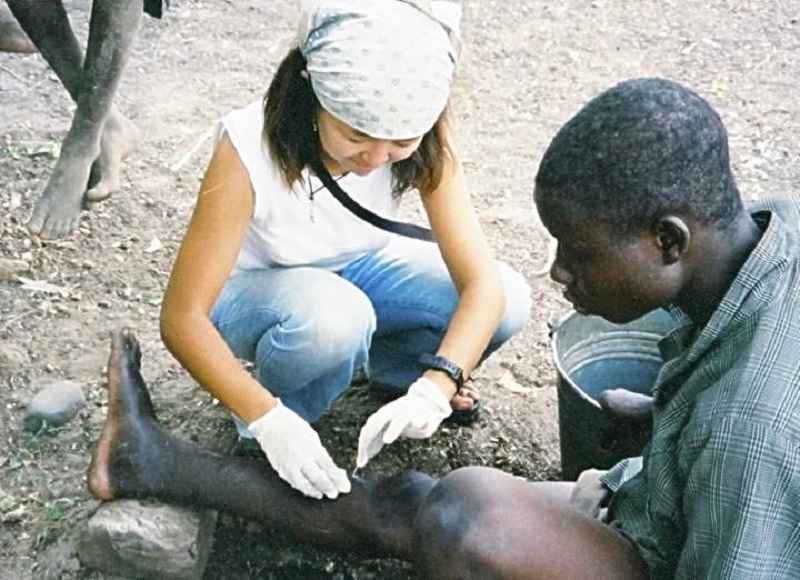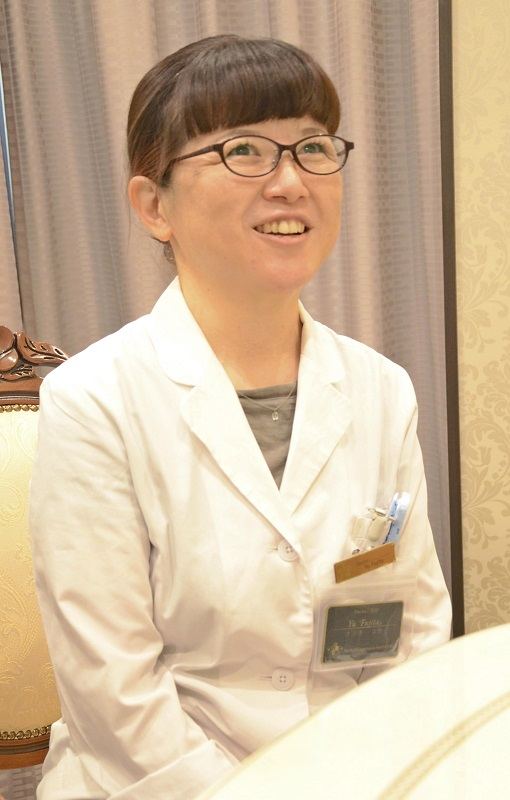Guinea worm disease could be eradicated

Yu Fujita treats a resident infected with Guinea worm disease in Togo around June 2004.
20:00 JST, October 8, 2022
Guinea worm disease, an infection caused by the Guinea worm and associated with severe pain, is now one step away from being eradicated. The disease mainly affects remote parts of Africa, with the number of annual human cases hitting 3.5 million in the 1980s. But that figure has fallen to just six this year as of August thanks to efforts led by a U.S. nongovernmental organization to eradicate the disease.

Yu Fujita
Yu Fujita, 47, an Osaka-based doctor who has worked in Togo in West Africa as a member of the organization, said the disease, a symbol of poverty, must be swiftly and completely eliminated.
Lasting, extreme pain
Fujita worked on Guinea worm disease eradication efforts in Togo as a member of the Carter Center from 2003 to 2004. She remembers when, not yet a licensed doctor, she helped treat a woman infected with Guinea worm disease in a village in northern Togo. Fujita said the woman screamed from the severe pain in her leg, and yelled, “It hurts more than giving birth!” Fujita held her down for treatment as she rolled about in pain.
Guinea worm is a parasite that lives mainly in sub-Saharan Africa. People become infected with Guinea worms by drinking unfiltered water from ponds and other stagnant water where the worms parasitize copepods, or “water fleas.”
The worm grows inside humans, causing a blister to develop on the skin. The blister gradually increases in size, causing a burning pain. It can eventually rupture, exposing the worm.
There are no drugs to kill the worm or vaccinations to prevent infection. The only cure is to remove the worm from the wound.
While the death rate for the disease is low, the extreme pain is long-lasting, leaving the patient unable to work or do household chores.
The infected person might put the affected body part in pond water to ease the symptoms. On contact with water, the worm discharges larvae into the water, spreading the infection.
“It was a cause of greater poverty for them,” Fujita said.
New lifestyle
The infection can be prevented by not drinking water that carries the worms, and efforts have been made to build safe wells and distribute filters to remove water fleas.
But it is not easy to change the lifestyles of locals. Even after wells were built, many residents did not use them, saying that the water in the pond they were used to drinking from tasted better. In some cases, they continued to use filters after they were broken.
The Carter Center, founded by former U.S. President Jimmy Carter, has been leading eradication efforts since 1986, focusing on providing residents with easy-to-understand information about Guinea worm disease and how to prevent it.
Fujita and others explained the effects of filters in a narrative style through plays and picture-based storytelling. They also asked reliable villagers to be local leaders and to report infections as soon as they found them.
Thanks to such efforts, the number of infections is said to have dropped dramatically.
Billions of yen from Japan
In January, the World Health Organization stated in its briefing on infectious diseases that Guinea worm disease is “on the verge of eradication.”
Only six cases have been confirmed this year, such as in Chad in Central Africa, and the disease is close to becoming the second infectious disease ever eradicated.
Japan has also made significant efforts to eradicate Guinea worm disease. The government has provided billions of yen in aid to Mauritania and other endemic countries for the construction of wells. In August, it awarded the Hideyo Noguchi Africa Prize to the Carter Center, recognizing the center for its outstanding achievement in the medical field.
However, Fujita, who obtained her medical license in 2014, said that “Eradication of the Guinea worm alone will not improve the lives of people in Africa.”
“I want to go to Africa again and work hard as a doctor to ensure safe childbirth,” she continued.
Smallpox 1st eradicated
Infections caused by parasites are common. Japan, for instance, has recorded cases in Hokkaido of echinococcosis, a disease transmitted by foxes.
Echinococcus eggs can sometimes be found in fox feces, and the disease is transmitted when people touch the eggs or drink water from a stream that carries the eggs.
The only infectious disease that has been eradicated so far is smallpox, which the WHO declared eradicated in 1980.
Prof. Kosuke Haruki at Dokkyo Medical University Saitama Medical Center said smallpox was successfully eradicated due to such factors as the infection route only being person-to-person, making quarantines an effective strategy, and the vaccine being effective.
“It would be gratifying to witness the eradication of parasites that have plagued humans,” said Meguro Parasitological Museum Director Toshiaki Kuramochi, “but the last stage of eradication is always tough and keeps us on our toes.”
"World" POPULAR ARTICLE
JN ACCESS RANKING




